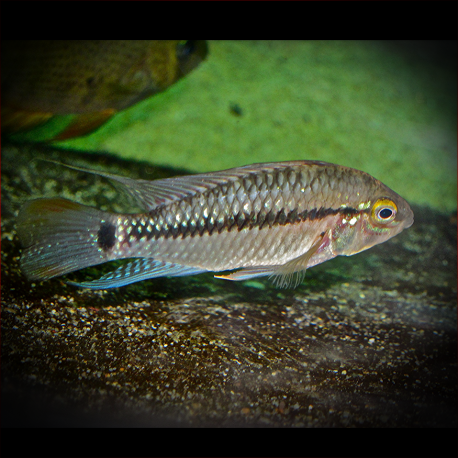More info
Datasheet
| Minimum Tank Size | 40 litres / 10.57 US gallons |
| Maximum Size | 5.5cm / 2.17inches |
| Temperature | 23°C / 73.40°F - 29°C / 84.20°F |
| Hardness | 0.00dgH / 0ppm - 5.04dgH / 90ppm |
| pH | 5.5-7.0 |
General Description
The Apistogramma Eunotus, belonging to the Perciformes order, is a species of South American cichlid assigned the code A73 under the DATZ ‘A-number’ system. This species is part of the Apistogramma genus, one of the most speciose South American cichlid genera with approximately 70 valid species at present.
Aquarium Setup
For an Apistogramma Eunotus, a well-planted tank with bogwood is recommended, as the released tannins benefit the water chemistry preferred by this species. Providing small caves, some inaccessible to the male, is crucial to allow the female a safe retreat due to potential male aggression. Additionally, mimicking its natural habitat by using dead leaves for substrate leaching organic compounds into the water is beneficial for maintaining soft, acidic conditions.
Behaviour
Captive-raised Apistogramma Eunotus are ideal for community aquariums, whereas wild specimens are best kept alone or with small 'dither' fishes like Nannostomus spp. They should generally not be mixed with other Apistogramma as they may exhibit territorial behavior.
Feeding and Diet
Primarily carnivorous, Apistogramma Eunotus feeds on benthic invertebrates in the wild. In an aquarium setting, they should be offered live and frozen foods like Artemia, Daphnia, and chironomid larvae regularly, with a possibility of accepting dried alternatives such as pellets over flakes.
Reproduction & Dimorphism
This species is a substrate spawner, with the female responsible for post-spawning care of eggs and fry. Males are larger, more colorful, and develop extended fins compared to females. In smaller aquaria, it may be necessary to remove the male to prevent hyper-aggression towards the female.
Habitat and Distribution
Apistogramma Eunotus, like most Apistogramma species, inhabits slow-moving streams, creeks, tributaries, and smaller rivers. They are described from the Río Ucayali near Pucallpa, Peru, and have a widespread distribution across tributaries of the system and the Solimões/Amazon, including basins like Itaya, Samiria, Ampiyacu, and Yavarí.

